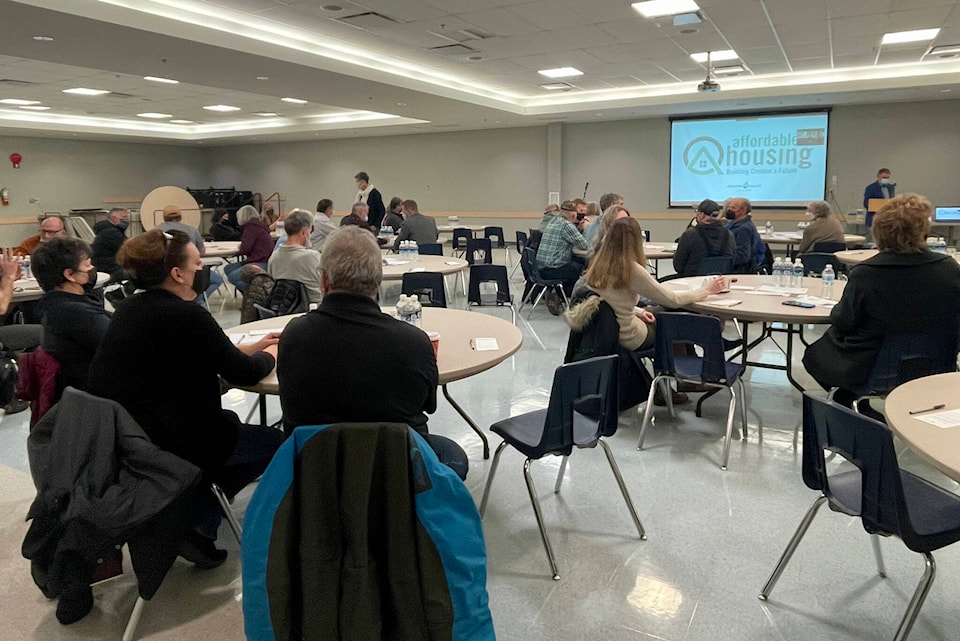Last week, the Town of Creston hosted an open forum to gather ideas from the community on how to address the complex issue of affordable housing.
Nearly 60 people were in attendance at the Creston and District Community Complex including town staff, local non-profits, land owners, contractors, developers, realtors, and members of the general public.
“It’s an ongoing conversation,” said Michael Moore, chief administrative officer.
“There’s no quick solution. As an organization, local government has a significant role, but we want to start connecting groups together and being a little bit more collaborative, so that we don’t duplicate efforts.”
What is affordable housing?
For housing to be considered affordable, less than 30 per cent of a household’s income should be spent on sheltering costs.
Not having access to affordable housing has significant negative impacts on physical and mental well being.
Housing assessment stats
In partnership with the Regional District of Central Kootenay (RDCK), an assessment report on regional housing needs was completed in September 2020.
Moore noted the data included in the report from Statistics Canada is several years old, but he doesn’t believe there have been major changes since then, except for the rising costs of real estate.
According to the report, the median household income for renters is approximately $23,700 and $57,200 for homeowners.
Approximately 22 per cent of Creston residents are considered low income, and as of 2019, the median rent was $863 per month.
From 2006 to 2016, there was a 30 per cent growth in unaffordable homes, and less than one per cent of rentals in the region were vacant in 2019.
In Creston, 58 per cent of rental tenants live in unaffordable housing, compared to the provincial average of 43 per cent. For homeowners, 12 per cent live in unaffordable housing, with a provincial average of 21 per cent.
“Creston’s population has grown modestly by about 5 per cent between the decade of 2006 to 2016,” said Moore.
“The estimate is by 2025, there will be a demand for 565 more units or an average of 63 annually. We are not building enough to keep up, since the number of new builds last year was only 32.”
Access to affordable housing is very difficult for families, people on income assistance, people on a fixed-income, and anyone with specialized needs.
Renting is becoming increasingly popular across all age groups, whether by choice or necessity.
Home ownership is generally out of reach for most single-income households. The data indicated that 67 per cent of renters would like to own but are unable to afford it.
Surveys with community members reflect these challenges, with one person saying, “There is no help for low income people to buy housing. Even if you can afford to buy, you still have to pay taxes and all of your utilities. Anyone on a fixed income can’t afford to pay all these bills and live.”
Another person interviewed said they are forced to live with family because of the lack of suitable rental housing.
Energy poverty is another significant issue in the Creston area, with 40 per cent of renters finding their bills unaffordable.
“Remember, when we talk about affordable housing, the 30 per cent of your income for housing costs includes those utility bills,” said Moore.
What has the town done?
As for what the Town of Creston is doing to address these issues, a new residential revitalization tax exemption (RTE) bylaw was introduced in January 2022. The RTE encourages rental housing units to be built by providing up to 100 per cent municipal tax relief with a 10 to 15 year agreement.
“When you do the math, that can be a fairly significant investment into development,” said Moore.
To ensure the quality, safety, and livability of rental housing units, the zoning bylaw within the Town of Creston’s Community Plan is being updated. The key highlights of the bylaw are increased density with smaller lots, decreased frontage requirements, and the ability for more diverse housing options.
“We have some really terrific landlords in the community, but on occasion we do hear of people living in garden sheds, carports or the crawl space of a house, with no access to facilities,” said Moore.
“And when people get desperate, they’ll do anything to put a roof over their head. We want to make sure that we’re able to
quickly correct these issues.”
In April, a public hearing will be held for the zoning bylaw.
The town plans to continue reducing fees, regulations, and barriers for to make developing rental suites easier for landowners and contractors.
So far, some development permit fees have been reduced and eliminated, and a rebate for rezoning fees has been created.
Affordable Housing Committee
Next, a committee will be formed to develop a housing strategy and action plan for the community.
Together, members of the committee will provide input to local officials regarding policies, programs, and incentives to support a range of housing options and affordability levels.
Town staff will also continue to increase the common knowledge base on affordable housing by implementing a public education campaign.
For the full presentation on affordable housing, visit letstalk.creston.ca/housing.
READ MORE: Creston RCMP seek information on $28K of stolen martial arts weapons
